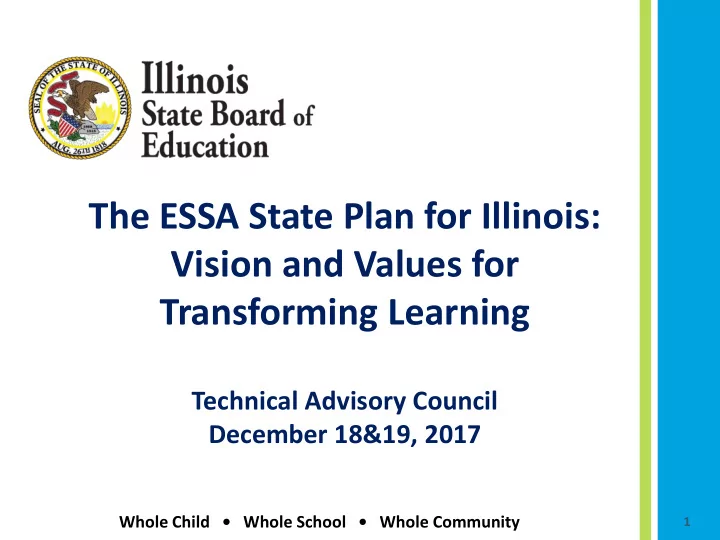

The ESSA State Plan for Illinois: Vision and Values for Transforming Learning Technical Advisory Council December 18&19, 2017 Whole Child • Whole School • Whole Community 1
Overview 2 ISBE Mission, Vision, and Goals ESSA State Plan Development Values IL EMPOWER Whole Child • Whole School • Whole Community
ISBE: Mission, Vision, and Goals 3 VISION Illinois is a state of whole, healthy children nested in whole, healthy systems supporting communities wherein all people are socially and economically secure. MISSION Provide leadership and resources to achieve excellence across all Illinois districts by engaging legislators, school administrators, teachers, students, parents, families, and other stakeholders in formulating and advocating for policies that enhance education, empower districts, and ensure equitable outcomes for all students.
ISBE: Vision, Mission, and Goals 4 GOALS Every child in each public school system in the State of Illinois deserves to attend a system wherein… All kindergartners are assessed for readiness. Ninety percent or more of third-grade students are reading at or above grade level. Ninety percent or more of fifth-grade students meet or exceed expectations in mathematics. Ninety percent or more of ninth-grade students are on track to graduate with their cohort. Ninety percent or more of students graduate from high school ready for college and career. All students are supported by highly prepared and effective teachers and school leaders. Every school offers a safe and healthy learning environment for all students.
The Whole Child A child within an ecology of multiple and interconnected parts nested in overlapping systems Cognitive Social Community Home School Physical Emotional 5
ESSA Design Principles Based on feedback from over 100 listening tour forums and meetings, hundreds of stakeholders, and more than 3,500 comments received online, stakeholders identified key design principles to guide the development Illinois’ new accountability system and statewide system of support: Educative , equitable , and non-punitive ; Grounded on the notion of identification for the purpose of support for schools and creating opportunities for children; and Recognizes and values the expertise located in local context . 6
Accountability: Measuring School Quality for P- 8 Schools Academic Indicators (75%) • PARCC and Dynamic Learning Maps Alternate Assessment (2018-19: English Language Arts 10%; Math 10%) (thereafter: ELA 7.5%; Math 7.5%) • Growth: Linear Regression (50%) • English Learner Proficiency (ACCESS) (5%) • Science (2018-19: 0%) (thereafter: 5%) School Quality/Student Success Indicators (25%) • Chronic Absenteeism (10%) • Climate Survey (5%) • Fine Arts (2018-19: 0%) (>0% by 2021-22) • P-2 Indicator (5%) • Elementary/Middle Indicator (5%) 7
Grade for Growth Each school will receive an A-F grade specifically for growth, as compared to schools with similar local contexts statewide. ISBE also will conduct an annual comparison all schools’ growth to proficiency. From the inception of the plan development, stakeholders identified equity – that each and every child receives and can take advantage of the supports and resources she or he needs – as the cornerstone of the ESSA State Plan for Illinois. As growth is very important to stakeholders and that how growth is represented within the accountability system will impact how resources are allocated, careful consideration of the practical consequences of any model must be at the forefront of the TAC work 8
Accountability: Measuring School Quality for High Schools Academic Indicators (75%) • SAT (2018-19: ELA 10%; Math 10%) (thereafter: ELA 7.5%; Math 7.5%) • Graduation (4-, 5-, and 6-year Rates) (50%) • English Learner Proficiency (ACCESS) (5%) • Science (2018-19: 0%) (thereafter: 5%) Student Quality/Student Success Indicators (25%) • Chronic Absenteeism (7.5%) • 9 th Grade on Track (6.25%) • College and Career Ready (6.25%) • Climate Survey (5%) • Fine Arts (2018-19: 0%) (>0% by 2021-22) 9
Summative Designations Tier 1: Exemplary School: A school that has no underperforming subgroups, a graduation rate of greater than 67 percent, and whose performance is in the top 10 percent of schools statewide . Schools that receive a Tier 1: Exemplary School designation may apply to serve in the IL-EMPOWER network of partners. Tier 2: Commendable School: A school that has no underperforming subgroups, a graduation rate greater than 67 percent, and whose performance is not in the top 10 percent of schools statewide . Schools that receive a Tier 2: Commendable School designation may apply to serve in the IL- EMPOWER network of partners. Tier 3: Underperforming School: A school in which one or more subgroups is performing at or below the level of the “all students” group in the lowest 5 percent of Title I schools . Schools that receive a Tier 3: Underperforming School designation will receive targeted support. Tier 4: Lowest Performing School: A school that is in the lowest-performing 5 percent of Title I schools in Illinois and those high schools that have a graduation rate of 67 percent or less . Schools that receive a Tier: 4 Lowest Performing School designation will receive comprehensive support through IL-EMPOWER. 10
IL-EMPOWER Guiding Principles 11 • Capacity development with differentiated support, customized for local context • Focus on equity within every school and for each and every child • Data informed by a collaborative inquiry process • Peer-to-peer learning opportunities • Continuous growth and development for results as an iterative process • Shift from doing to schools to doing with schools • Educator-led, state-supported • Assume positive intent Whole Child • Whole School • Whole Community
Questions 12
Recommend
More recommend